Paiements numériques
Les technologies numériques transforment la manière dont nous répondons aux urgences. Les innovations sont multiples : elles concernent l’identification des personnes ayant droit à une aide, la collecte des données pour les évaluations et le suivi ou encore la communication aux communautés affectées par la crise. Les systèmes de paiement numérique, dont les appareils mobiles, les coupons électroniques et les cartes, lorsqu’ils sont utilisés de manière appropriée, peuvent accélérer, sécuriser et optimiser l’assistance, la rendant également plus inclusive. Toutefois, le volume de données personnelles que nous collectons, stockons et partageons augmentant, nous devons nous assurer que nos systèmes de protection des données restent pertinents et veiller à comprendre et atténuer les risques associés aux nouvelles technologies.
Contenu associé

Podcast: Is informed consent possible in humanitarian CVA?
Podcast
Episode 2 of the CashCast tackles data responsibility with Amos Doornbos, Linda Raftree, James Eaton Lee and Ric Tighe

Consent and Ownership in the Shift to Digital Cash and Voucher Assistance
Blog Post
Part of committing to cash and voucher assistance (CVA) is committing to going digital and collecting data. While they are two different things, they are deeply intertwined. And while an organisation can ‘go digital’ without cash programmes, it’s nearly impossible to commit to cash programmes in the long term without going digital. Yes, it is true we’ve done cash and voucher programmes...
Contenu récent

An Innovative way of Humanitarian Assistance using Mobile Money Transfer in Bangladesh
Presentation
A video detailing Oxfam’s use of mobile money transfer in Bangladesh.

ICT/mobile Phone Technology: A shift in the right direction
Blog Post
Thirteen African nations came together for the AgriKnowledge Share Fair in Addis Ababa at the end of October 2012 to learn about approaches for quicker and more efficient humanitarian response. Government representatives, researchers, UN agencies and NGOs gathered for a three day symposium on best...

New Technologies in Cash Transfer Programming and Humanitarian Assistance – Executive Summary
Report
This is the executive summary of the CALP Network’s research on new technologies in cash transfer programming and humanitarian assistance. For more, please see the full report.
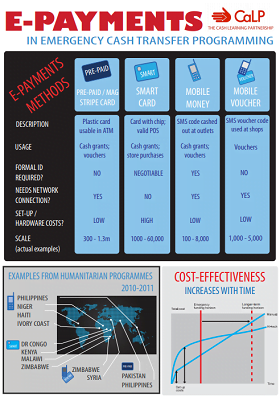
E-payments in Emergency Cash Transfer Programming
Guidelines and Tools
This 2-pager summarises some of the main features, benefits and challenges of 4 different electronic payment methods that can be used to deliver cash transfers in an emergency: pre-paid cards, smart cards, mobile money and mobile vouchers. It is drawn from the CALP Network research on New Technologies in...

MPESA Project Analysis: Exploring the use of cash transfers using cell phones in pastoral areas
Report
Safaricom Limited, a mobile network operator in Kenya, launched a mobile money transfer system called M-PESA in 2007. This system allows users to send or receive money on their Safaricom SIM card. Télécoms sans Frontières and Vétérinaires sans Frontières – Germany decided to work in partnership on...
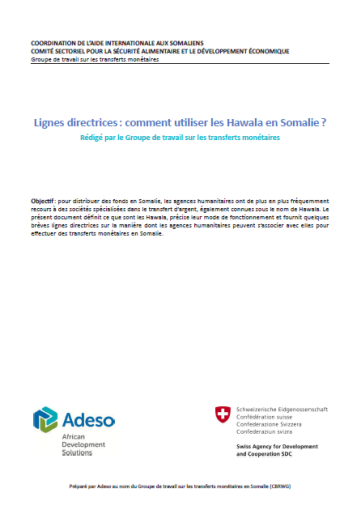
Lignes directrices : comment utiliser les Hawala en Somalie ?
Guides et outils
Pour distribuer des fonds en Somalie, les agences humanitaires ont de plus en plus fréquemment recours à des sociétés spécialisées dans le transfert d’argent, également connues sous le nom de Hawala. Le présent document définit ce que sont les Hawala, précise leur mode de fonctionnement et...
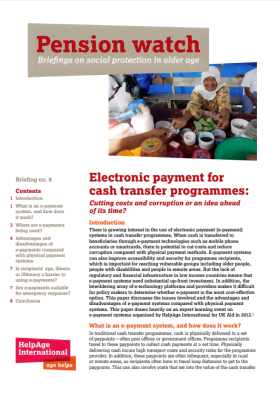
Pension Watch Briefing #8: Electronic payment for cash transfer programmes
Policy paper
There is growing interest in the use of electronic payment (e-payment) systems in cash transfer programmes. When cash is transferred to beneficiaries through e-payment technologies such as mobile phone accounts or smartcards, there is potential to cut costs and reduce corruption compared with physical...
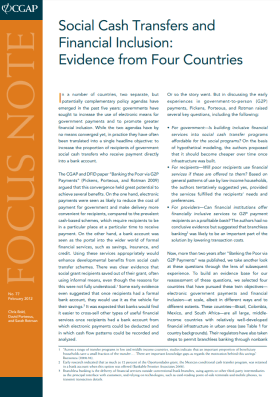
Social Cash Transfers and Financial Inclusion: Evidence from four countries
Report
This focus note from CGAP looks at social cash transfers and how this is being used to improve financial inclusion. To do so they look at examples from Brazil, Colombia, Mexico and South Africa. The focus note compares the various payment approaches, how these interlink with the respective government...

Mobile Technology in Emergencies
Policy paper
Mobile phones are increasingly accessible to those affected by crisis and can play a strategic role in the delivery of rapid, cost-effective, scalable humanitarian assistance. However, the full potential of mobile phones to work as transformative tools in emergency response has not yet been realised. This...

New Technologies in Cash Transfer Programming and Humanitarian Assistance
Report
This study was commissioned by the the CALP Network in 2011, to review the current use of new technology in humanitarian cash and voucher programming and the broader implications for humanitarian practice. The research was undertaken to explore (i) preconditions for the use of technological...
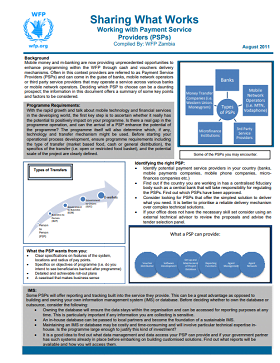
Sharing What Works – Working with payment service providers (PSPs)
Report
A handy tool on choosing payment service providers for delivering cash transfers developed by WFP Zambia. Mobile money and m-banking are now providing unprecedented opportunities to enhance programming within the WFP through cash and vouchers delivery mechanisms. Often in this context providers are...
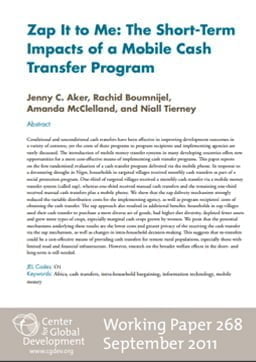
Zap It to Me: The Short-Term Impacts of a Mobile Cash Transfer Program
Report
Conditional and unconditional cash transfers have been effective in improving development outcomes in a variety of contexts, yet the costs of these programs to program recipients and implementing agencies are rarely discussed. The introduction of mobile money transfer systems in many developing...

Electronic Payment Systems 201
Guidelines and Tools
Disruptive innovation in the payments sector—and indeed the retail financial services industry—does not occur frequently. This is partly due to the dominant position of the incumbent players (primarily banks and payment networks), and partly due to the nature of the sector itself: as they relate to...
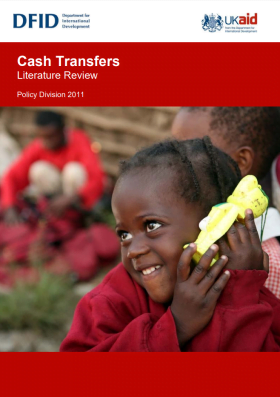
DFID Cash Transfers Literature Review
Report
This paper provides a synthesis of current global evidence on the impact of cash transfers in developing countries, and of what works in different contexts, or for different development objectives. Cash transfers are direct, regular and predictable non-contributory cash payments that help poor and...
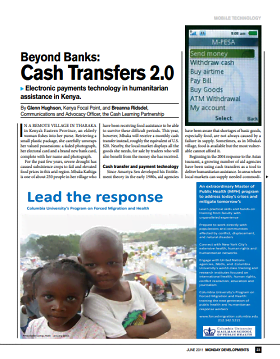
Beyond Banks: Cash Transfers 2.0 – Electronic payments technology in humanitarian assistance in Kenya
Report
This article in Monday Developments Magazine (June 2011) looks at how the emergence of new technologies in the financial sector in Kenya – namely remote banking and mobile phone banking – have the potential to enable aid organisations to delivery money to unprecedented numbers of people, with record...
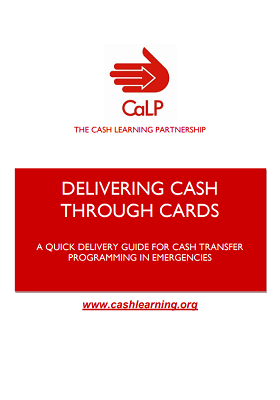
Delivering Cash through Cards: A quick delivery guide for cash transfer programming in emergencies
Guidelines and Tools
A Quick Delivery Guide to delivering money through cards (magnetic stripe or smart cards). Prepared as a practical tool, this guide provides a brief synthesis of the necessary preconditions and advantages and disadvantages of using cheques. It also provides practical implementation tips.
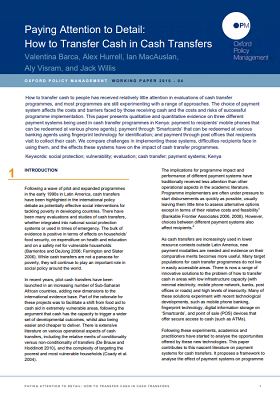
Paying attention to detail: How to transfer cash in cash transfers
Report
This policy working paper looks at various delivery mechanisms which can be used to transfer cash to people in cash interventions. It discusses how these affect the costs, and the barriers, faced by those receiving cash as well as the costs and risks to implementing agencies of successful programme...
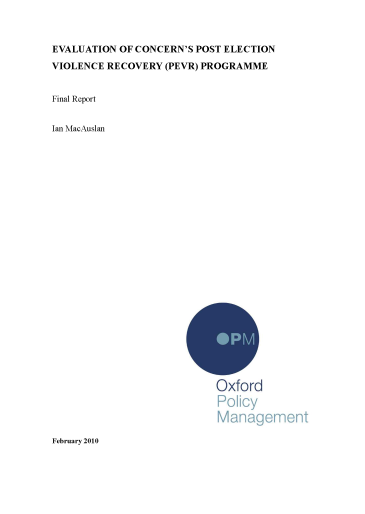
Evaluation of Concern’s Post Election Violence Recovery (PEVR) programme
Case Study
Concern’s Post Election Violence Recovery (PEVR) Programme was a cash transfer programme operating in areas of Kenya (Nairobi, Nyanza, and the Rift Valley) affected particularly badly by the violence that followed the announcement of the national election results in late 2007. Building on several other...
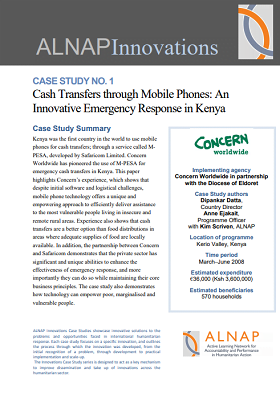
Cash Transfers through Mobile Phones: An Innovative Emergency Response in Kenya
Case Study
Kenya was the first country in the world to use mobile phones for cash transfers; through a service called M-PESA, developed by Safaricom Limited. Concern Worldwide has pioneered the use of M-PESA for
emergency cash transfers in Kenya. This paper highlights Concern’s experience, which shows that despite...

Evaluation of Concern Kenya’s Kerio Valley Cash Transfer Pilot (KVCTP)
Report
The Kerio Valley Cash Transfer Pilot (KVCTP) was Concern and its local partner the Catholic Diocese of Eldoret’s short-term and targeted response to the food security problems that affected communities in four Sub-locations in Baringo North and Pokot East Districts as a result of the post election...